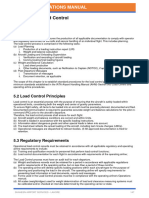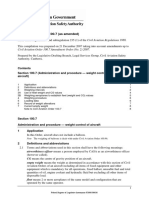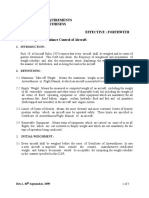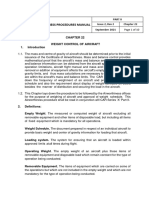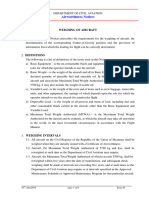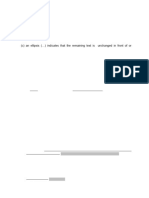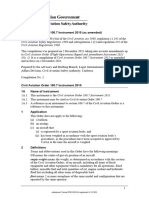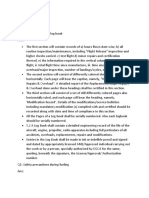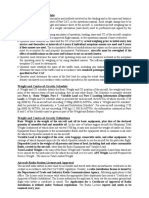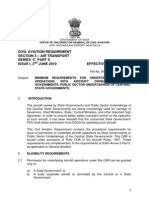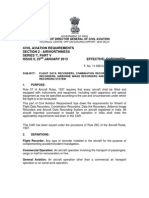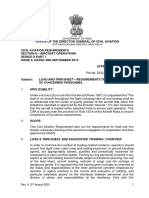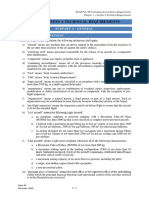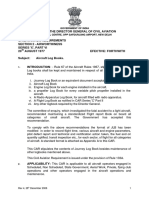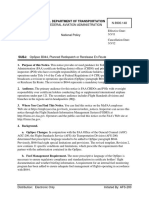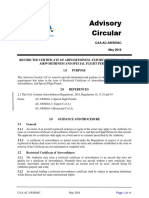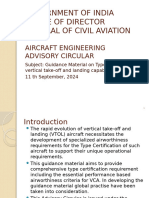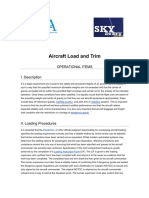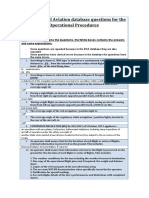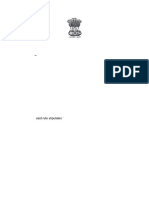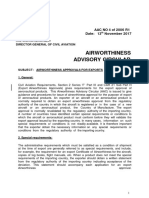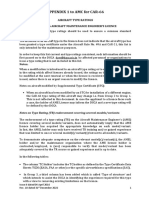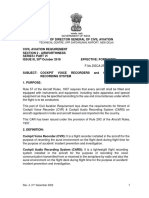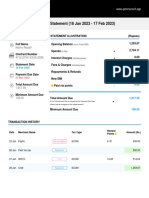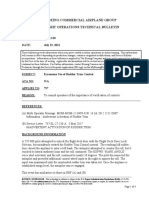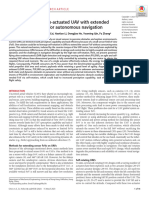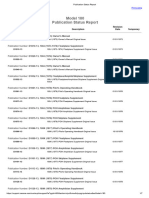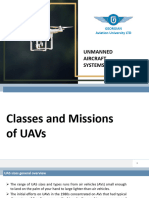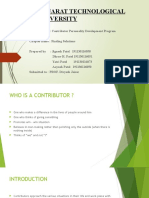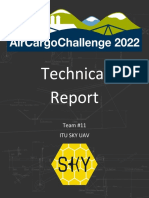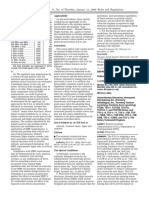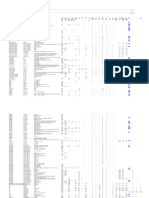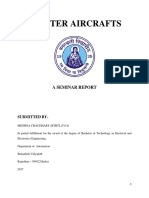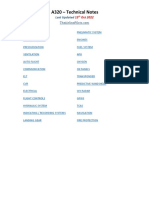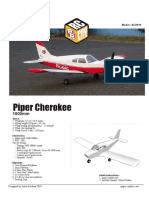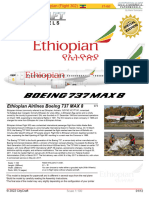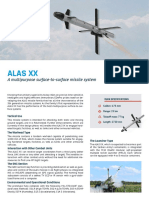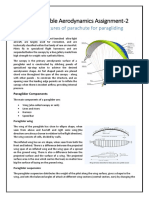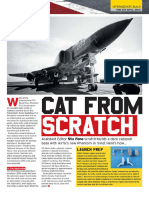D2X-X2 (Rev9 Jan2023) PDF
D2X-X2 (Rev9 Jan2023) PDF
Uploaded by
noohu naasifCopyright:
Available Formats
D2X-X2 (Rev9 Jan2023) PDF
D2X-X2 (Rev9 Jan2023) PDF
Uploaded by
noohu naasifOriginal Title
Copyright
Available Formats
Share this document
Did you find this document useful?
Is this content inappropriate?
Copyright:
Available Formats
D2X-X2 (Rev9 Jan2023) PDF
D2X-X2 (Rev9 Jan2023) PDF
Uploaded by
noohu naasifCopyright:
Available Formats
GOVERNMENT OF INDIA
OFFICE OF THE DIRECTOR GENERAL OF CIVIL AVIATION
TECHNICAL CENTRE, OPP. SAFDARJUNG AIRPORT, NEW DELHI-110 003
CIVIL AVIATION REQUIREMENTS
SECTION 2 - AIRWORTHINESS
SERIES X PART II
14TH MAY, 1993 EFFECTIVE: FORTHWITH
File No. DGCA-25012(07)/8/2020-AW
Subject : Weight and Balance Control of Aircraft.
1. INTRODUCTION :
Rule 58 of Aircraft Rules, 1937 requires that every aircraft shall be weighed and its
centre of gravity determined. This CAR lays down the frequency of weighment and
preparation of weight schedule and also the requirement about display or carriage of
the weight schedule on board besides the manner of distribution and securing the load
in the aircraft.
2. DEFINITIONS :
2.1 Empty Weight : Means the measured or computed weight of an aircraft, excluding the
weight of all removable equipment and other items of disposable load, but including
the weight of all items of fixed operating equipment or other equipment which are
mandatory for all operations like fixed ballast, engine coolant, hydraulic fluid and fuel
and oil quantities (both trapped and unusable) in the aircraft and engine system.
2.2 Limits of Centre of Gravity : Means the most forward and most rearward Centre of
Gravity position within which an aircraft may be operated safely. These limits are
specified in Certificate of Airworthiness/Flight Manual of an aircraft.
2.3 Maximum Take-off Weight : Means the maximum weight, according to its Certificate
of Airworthiness or Flight Manual, at which an aircraft is permitted to take-off.
2.4 Removable Equipment : Means items of equipment which are carried on some of or
on all flights, but which are not included in Empty weight and which are not mandatory
Rev. 9, 17th January 2023
1
CIVIL AVIATION REQUIREMENTS SECTION 2 - AIRWORTHINESS
SERIES X PART II 14TH MAY, 1993
for the type of operation being conducted.
3. INITIAL WEIGHMENT :
3.1 Every aircraft shall be weighed before the issue of Certificate of Airworthiness. In
case a new aircraft is imported from outside the country, weight schedules issued by
the manufacturer or the previous operator weight schedule based on the
manufacturer's certificated weight and balance documents would be acceptable.
4. Requirements for Reweighing of an Aircraft of Maximum Take-off weight (MTOW)
less than 2000 kg.
4.1 Aircraft weighing less than 2000 kg. need not be reweighed on routine basis, unless it
is required to be reweighed in accordance with para 4.3 of this CAR.
4.2 Requirements for Reweighing Aircraft of Maximum Take-off weight (MTOW) more
than 2000 kg.
Aircraft weighing more than 2000 kg. shall be re-weighed every five years unless it is
required to be re-weighed in accordance with para 4.3 of this CAR. However operators
may approach Regional Airworthiness Offices (through the Sub-Regional Airworthiness
Offices, as applicable) for an adhoc extension of the weighment period of an aircraft by
a maximum of 3 months to tide over the operational exigencies. Such requests for
extension may be agreed upon by Regional Airworthiness Office, if satisfied with the
reasons advanced by the operator for his request. Extension of weighment beyond 3
months may be granted by Director of Airworthiness of the concerned region under
intimation to Headquarters promptly.
4.3 Requirements for Reweighing after major Repair/ Alterations:
An aircraft shall be required to be reweighed if it has undergone major repair, or major
alteration or there has been major change in the interior arrangement of pilot/pax/cargo
compartments which affect already determined weight and balance data and which
cannot be accurately computed without fresh weighment. Decision of the DGCA whether
the aircraft requires reweighing after major repair/ alteration, or change in interior
arrangement, shall be final.
4.4 The renewal of the Certificate of Airworthiness of an aircraft shall be subjected to
following of the requirements of para 4.
4. Director General of Civil Aviation may require the reweighment of an aircraft at any time
if he considers it necessary.
5. FORM OF WEIGHT SCHEDULE :
After the aircraft has been weighed as required, the following persons shall prepare
Rev. 9, 17th January 2023
2
CIVIL AVIATION REQUIREMENTS SECTION 2 - AIRWORTHINESS
SERIES X PART II 14TH MAY, 1993
the weight Schedule.
(i) A person specifically approved by DGCA for the purpose in any organization.
OR
(ii) A person specifically approved by Quality Manager in an organization approved
under CAR 145 provided procedure for grant of such approval is documented in
Maintenance Organization Exposition.
OR
(iii) A Category "B" licensed AME as reflected in item no XIV (a) Annexure to the
CAR-66 licence (privileges inherited from the AME licence held prior to CAR- 66
licence).
The Weight Schedule shall contain at least the following information :-
(i) Type of Aircraft.
(ii) Registration Marking and Serial No. of aircraft.
(iii) Empty weight including weight of unusable quantity of fuel and oil (kg.).
(iv) Item wise Weight and details of removable equipment (kg.) (Including wireless
equipment).
(v) Maximum fuel capacity (Usable) in liters and kg.
(vi) Maximum oil capacity (Usable) in liters and kg.
(vii) Maximum commercial weight with fuel and oil tanks full.
(viii) MTOW (as per Certificate of Airworthiness/ Flight Manual) (kg.).
(xi) Empty weight Centre of Gravity.
(xii) Centre of Gravity Range and datum.
(xiii) Maximum number of passengers.
(xiv) Signature of appropriately licensed AME/ Approved person.
(xv) Date of weighment.
7. APPROVAL BY AIRWORTHINESS OFFICE :
The Regional/Sub-regional Airworthiness office shall be intimated in advance about the
weighing of the aircraft who may associate with the weighing process. The weighing of
the aircraft shall be done in supervision of the Quality Manager or his representative,
who shall be responsible for following the documented procedures of weighment. The
duly signed weight schedule shall be submitted to Regional /Sub-Regional Airworthiness
Office along with the computation details and weighment printout if available. After
scrutiny the weight schedule shall be approved by Regional Airworthiness Office.
Rev. 9, 17th January 2023
3
CIVIL AVIATION REQUIREMENTS SECTION 2 - AIRWORTHINESS
SERIES X PART II 14TH MAY, 1993
8. DISPLAY OR CARRIAGE IN THE AIRCRAFT AND PRESERVATION OF
RECORDS :
A copy of the approved weight schedule must be displayed at a suitable and prominent
place. When carried on board it should be easily accessible to the crew/authorized
person. All persons concerned directly with the loading of the aircraft shall be duly
informed of the various weight figures for exercising proper weight and balance control
of the aircraft. A copy of the weight schedule must be retained along with other
documents of the aircraft or in the aircraft log book, till it is replaced by a fresh weight
schedule.
9. COMPUTATION OF CENTRE OF GRAVITY:
9.1 For all flights, it shall be the responsibility of the Pilot-in-Command to ensure that the
aircraft is satisfactorily loaded with respect to the total load, the distribution of the load
and proper securing of the load in aircraft (lashing of the load). The distribution of the
load shall be such that the C.G. position will remain within the specified limits at the time
of take off, during the progress of the flight and at the time of landing.
9.2 In the case of scheduled operator, the responsibility for loading, lashing and
computing C.G. position, for take-off and landing phases of flight as stated in the
previous paragraph may be delegated to a person nominated by the operator, who is
specifically trained and authorised (by the operator) for the purpose. However, Centre
of Gravity position computed by the nominated person shall be signed and dated by
him and the same shall be submitted to the Pilot-in-Command of the aircraft for his
scrutiny and acceptance; the acceptance would be denoted by the pilot by affixing the
dated signature.
9.3 In case a method other than the "direct calculating method" for the purpose of
computing C.G. is employed, the same shall be submitted to the Regional
Airworthiness Office for approval before adoption.
9.4 Every operator including scheduled, non-scheduled, State Government and private
aircraft operator shall prepare load and trim sheet for aircraft where the manufacturer
has provided necessary documentation for the purpose. The load and trim sheet shall
indicate the composition and the distribution of the total load carried on board the
aircraft as well as the calculated C.G. position for "take-off and landing" configurations
before the commencement of the flight. Such load sheets shall be prepared and
signed by the Pilot-in-Command or persons duly trained in accordance with CAR
Section 8 Series 'D' Part I and responsible for supervising the loading of aircraft. In
case the load and trim sheet is prepared by a person other than the Pilot-in-Command,
the same shall be submitted to the Pilot for his scrutiny and signatures before the
commencement of the flight. One copy of the load sheet shall be carried on board the
aircraft and one copy shall be retained by the operator for record purposes for a period
of altleast four months from the date of issue.
Rev. 9, 17th January 2023 4
CIVIL AVIATION REQUIREMENTS SECTION 2 - AIRWORTHINESS
SERIES X PART II 14TH MAY, 1993
10. STANDARD WEIGHT OF FLIGHT CREW/ PASSENGERS:
10.1 For preparation of load sheet and calculation of Centre of Gravity as mentioned in
para 9.4 above, the minimum standard weight (including handbag) as given below,
shall be applied in all civil registered aircraft:
1. Crew 85 (75+10) kg.
2. Adult passenger (both Male & Female) 75 kg.
3. Child (Between 2 years and 12 years age) 35 kg.
4. Infant (Less than two years) 10 kg.
10.2 Notwithstanding para 10.1, the actual weight of the passenger could be considered
for aircraft (excluding helicopter) MTOW up to 2000 kg provided the arrangement for
passenger weighment with sufficient accuracy is ensured.
10.3 For all helicopters irrespective of AUW, the actual weight of crew, passengers and
baggage shall be considered for calculation of AUW. Arrangements shall be ensured
by the operator for passenger weighment with sufficient accuracy.
11. CALIBRATION OF WEIGHING SCALES:
11.1 The weighing scales used for the purpose of weighment of passenger baggage,
goods etc. shall be calibrated at specified intervals to the satisfaction of the Quality
Manager/ DGCA. The Quality Manager is required to bring this requirement to the
notice of the concerned persons for compliance.
11.2 The weighing scales used for the purpose of weighment of aircraft shall be
calibrated at specified intervals. This requirement may be reflected in the
Maintenance Organisation Exposition.
12. INSTRUCTIONS FOR SAFE LOADING:
12.1 Specific seats shall be allotted to all passengers boarding at originating stations of
flights so that centre of gravity of the aircraft can be calculated accurately and the
C.G. is kept within the permissible limits.
12.2 During loading, it must be ensured that aircraft cabin floor loading limitations are
not exceeded.
12.3 The load must be securely tied so that there is no possibility of the load shifting in
flight and disturbing the calculated C.G. position.
12.4 The load must be tied at the specified places provided in the aircraft and the tying
ropes must be of sufficient strength to withstand the loads imposed on it in flight.
Rev. 9, 17th January 2023 5
CIVIL AVIATION REQUIREMENTS SECTION 2 - AIRWORTHINESS
SERIES X PART II 14TH MAY, 1993
12.5 While placing cargo in the passenger cabin during mixed version( passenger cum
freight) operation, the load must be placed ahead of the passengers in the cabin, the
load must not block "emergency exit" meant to be used by the passengers
during " emergencies ".
13. OBSERVANCE OF SAFETY INSTRUCTIONS:
The safety instructions required to be observed, as detailed in para 9, 10 and 12 above,
shall be observed by Pilot-in-Command of non-scheduled operators, aerial work
aircraft operators including flying clubs and private aircraft operators.
In the case of scheduled operators, a comprehensive manual (Weight and Balance
Manual) shall be prepared describing the safety requirements of para 9, 10 and 12 for
compliance by the concerned staff.
(Arun Kumar)
Director General of Civil Aviation
Rev. 9, 17th January 2023 6
You might also like
- Serenity - Serenity BlueprintsDocument12 pagesSerenity - Serenity Blueprintsjackr573705100% (1)
- GOM - Load ControlDocument8 pagesGOM - Load Controlayazahmed.saps100% (1)
- Aircraft Rules and Regulations Full NotesDocument240 pagesAircraft Rules and Regulations Full NotesVinay MP75% (4)
- Cao 100.7 PDFDocument8 pagesCao 100.7 PDFTDNo ratings yet
- AOI 13 Airside Driving Training and Regulations of Airside Safety PDFDocument23 pagesAOI 13 Airside Driving Training and Regulations of Airside Safety PDFSatyendra Pandey100% (1)
- Aircraft Weight and Balance Handbook: FAA-H-8083-1AFrom EverandAircraft Weight and Balance Handbook: FAA-H-8083-1ARating: 5 out of 5 stars5/5 (1)
- Subject: Weight and Balance Control of AircraftDocument5 pagesSubject: Weight and Balance Control of AircraftjanhaviNo ratings yet
- APM - Part 2 Chapter 22Document10 pagesAPM - Part 2 Chapter 22ShivamSrivastavaNo ratings yet
- AC - 03 Verification of Operations Derived Equipment - January 2020Document18 pagesAC - 03 Verification of Operations Derived Equipment - January 2020AnonymousNo ratings yet
- Airworthiness Notices: Weighing of AircraftDocument6 pagesAirworthiness Notices: Weighing of AircraftzylusedinairkbzNo ratings yet
- Series - TDocument10 pagesSeries - TAryan LahariaNo ratings yet
- Car D2T-T2Document10 pagesCar D2T-T2Pravin HandeNo ratings yet
- D2T-T2(Draft_Sept2017)Document10 pagesD2T-T2(Draft_Sept2017)Namasvi BhilareNo ratings yet
- Government of India Technical Centre, Opp Safdurjung Airport, New DelhiDocument27 pagesGovernment of India Technical Centre, Opp Safdurjung Airport, New DelhiPiyushNo ratings yet
- F2021C01234Document10 pagesF2021C01234CNo ratings yet
- D2T T2 PDFDocument11 pagesD2T T2 PDFaadhya guptaNo ratings yet
- UntitledDocument8 pagesUntitledBhashkar chouhanNo ratings yet
- Office of The Director General of Civil Aviation: Government of India Opposite Safdarjung Airport, New Delhi - 110 003Document26 pagesOffice of The Director General of Civil Aviation: Government of India Opposite Safdarjung Airport, New Delhi - 110 003mohan reddyNo ratings yet
- Latest DGCA REQUIREMENTS FOR IMPLEMENTATION OF REDUCED VERTICAL SEPARATION MINIMUM (RVSM). CIVIL AVIATION REQUIREMENTS SECTION 8 – AIRCRAFT OPERATIONS SERIES 'S', PART II ISSUE I, 17th JANUARY, 2013 D8S-S2.pdfDocument23 pagesLatest DGCA REQUIREMENTS FOR IMPLEMENTATION OF REDUCED VERTICAL SEPARATION MINIMUM (RVSM). CIVIL AVIATION REQUIREMENTS SECTION 8 – AIRCRAFT OPERATIONS SERIES 'S', PART II ISSUE I, 17th JANUARY, 2013 D8S-S2.pdfjames_008No ratings yet
- Weight & BalanceDocument1 pageWeight & BalanceMarshal BhandaryNo ratings yet
- Powered Hang GliderDocument26 pagesPowered Hang GliderSunny x10No ratings yet
- CAR M NotesDocument15 pagesCAR M NotesMistry AbhirajNo ratings yet
- Civil Aviation Requirement Section 3 - Air Transport Series C' Part X Issue I, 2 JUNE 2010Document11 pagesCivil Aviation Requirement Section 3 - Air Transport Series C' Part X Issue I, 2 JUNE 2010riyaz_sk100% (1)
- CLO 5 (10.5b) - Week 10 NotesDocument20 pagesCLO 5 (10.5b) - Week 10 Notesabubakarraza2924No ratings yet
- PDF Aircraft Rules and Regulations Full Notes CompressDocument92 pagesPDF Aircraft Rules and Regulations Full Notes CompressDr. S. Arunvinthan Faculty, AeronauticalNo ratings yet
- Npa 09-2013 - Caap 71 Helidecks (Off-Shore)Document32 pagesNpa 09-2013 - Caap 71 Helidecks (Off-Shore)Legend AnbuNo ratings yet
- D2F-F7 (R7 April2024)Document6 pagesD2F-F7 (R7 April2024)sureshrnalNo ratings yet
- CAR Series - Unit 1, 2Document77 pagesCAR Series - Unit 1, 2sarathkumar sebastinNo ratings yet
- D8O-O6 (R3 13oct2023)Document26 pagesD8O-O6 (R3 13oct2023)Tirth BhanderiNo ratings yet
- Civil Aviation Requirements Section 2 - Airworthiness Series 'O' Part Vi 14 JULY, 1993 Effective: ForthwithDocument18 pagesCivil Aviation Requirements Section 2 - Airworthiness Series 'O' Part Vi 14 JULY, 1993 Effective: ForthwithArti RainaNo ratings yet
- D2F F6 PDFDocument4 pagesD2F F6 PDFNihal DanielNo ratings yet
- RVSMDocument26 pagesRVSMSagar ValsanNo ratings yet
- Issue, Renew and Validation of Certificate of Airworthiness (C of A)Document8 pagesIssue, Renew and Validation of Certificate of Airworthiness (C of A)Ye MinNo ratings yet
- APM - Part 2 Chapter 28Document32 pagesAPM - Part 2 Chapter 28ShivamSrivastavaNo ratings yet
- Aircraft Rules and Regulations Notes (Semester-5) PDFDocument158 pagesAircraft Rules and Regulations Notes (Semester-5) PDFsatyam singhNo ratings yet
- CT-11-007 Special Flight PermitDocument7 pagesCT-11-007 Special Flight PermitVladimyr Vera CruzNo ratings yet
- Latest Civil Aviation Requirements DGCA INDIA On SSFDRs D2I-I5 PDFDocument34 pagesLatest Civil Aviation Requirements DGCA INDIA On SSFDRs D2I-I5 PDFjames_008No ratings yet
- Civil Aviation Amendment Order (No. R8) 2004: (Signed Bruce Byron)Document5 pagesCivil Aviation Amendment Order (No. R8) 2004: (Signed Bruce Byron)greg mNo ratings yet
- CAR Section 8, Series 8 Part 1Document14 pagesCAR Section 8, Series 8 Part 1Amit JhaNo ratings yet
- Ano-004-Awrg-5.0-Requirements For Certificate of AirworthinessDocument10 pagesAno-004-Awrg-5.0-Requirements For Certificate of Airworthinessafa.maintNo ratings yet
- Flight Operation Requirement (For), Flight Plan and Fuel PlanDocument7 pagesFlight Operation Requirement (For), Flight Plan and Fuel Planadityarana531No ratings yet
- Issue 02, Feb 016 PDFDocument263 pagesIssue 02, Feb 016 PDFsan2inNo ratings yet
- Flight Log BooksDocument12 pagesFlight Log Bookshannybag12350% (2)
- N 8900.148 PDFDocument5 pagesN 8900.148 PDFMuhammad Fikri Kawakibi HudaNo ratings yet
- CAA-AC-AWS004C Restricted Certificate of Airworthiness, Export C of A and Special Flight Permit - May 2018-1Document11 pagesCAA-AC-AWS004C Restricted Certificate of Airworthiness, Export C of A and Special Flight Permit - May 2018-1Purity SidiNo ratings yet
- Guidance Material For eVTOL Certification - DGCADocument61 pagesGuidance Material For eVTOL Certification - DGCAhitesh kulkarniNo ratings yet
- GCAA Air Leg Essay QuestionsDocument48 pagesGCAA Air Leg Essay QuestionsaksankebedeNo ratings yet
- Aircraft Load and TrimDocument6 pagesAircraft Load and Trimcthembree0% (1)
- D8S-S2 (RVSM)Document23 pagesD8S-S2 (RVSM)BFBGFDNo ratings yet
- C of A PDFDocument21 pagesC of A PDFRaj Kumar DepalliNo ratings yet
- Paper 1 ExtractDocument107 pagesPaper 1 Extractsprashant19No ratings yet
- CAO 101.55 (Now Revoked)Document23 pagesCAO 101.55 (Now Revoked)Eric J. WhitneyNo ratings yet
- All 680 Bristol Aviation Database Questions For The Operational Procedures ExamDocument51 pagesAll 680 Bristol Aviation Database Questions For The Operational Procedures ExamCarlos Eduardo BeckerNo ratings yet
- Government of India Technical Centre, Opp Safdurjung Airport, New DelhiDocument6 pagesGovernment of India Technical Centre, Opp Safdurjung Airport, New Delhiarjun vsNo ratings yet
- D2X-X6 (Issue II - December 2023)Document13 pagesD2X-X6 (Issue II - December 2023)pankaj SharmaNo ratings yet
- Civil Aviation Requirements Section 2 - Airworthiness Series I' Part Ii 24 APRIL, 1992 Effective: ForthwithDocument12 pagesCivil Aviation Requirements Section 2 - Airworthiness Series I' Part Ii 24 APRIL, 1992 Effective: ForthwithRajib DasNo ratings yet
- TCASDocument9 pagesTCASvikash_kumar_thakurNo ratings yet
- Government of India Technical Centre, Opp Safdurjung Airport, New DelhiDocument6 pagesGovernment of India Technical Centre, Opp Safdurjung Airport, New DelhiAnoop singhNo ratings yet
- Government of India Technical Centre, Opp Safdarjang Airport, New DelhiDocument24 pagesGovernment of India Technical Centre, Opp Safdarjang Airport, New DelhiRutuja DeshmukhNo ratings yet
- Aac4 2006 (R1)Document11 pagesAac4 2006 (R1)slam12125No ratings yet
- Aircraft Weight and Balance Handbook (2025): FAA-H-8083-1BFrom EverandAircraft Weight and Balance Handbook (2025): FAA-H-8083-1BRating: 3.5 out of 5 stars3.5/5 (1)
- CAR 66 (App1toAMC) PDFDocument16 pagesCAR 66 (App1toAMC) PDFnoohu naasifNo ratings yet
- D2I-I6 (R4 Dec2022) PDFDocument14 pagesD2I-I6 (R4 Dec2022) PDFnoohu naasifNo ratings yet
- SR HYD Notification-AC-Technicians - 22022023Document13 pagesSR HYD Notification-AC-Technicians - 22022023noohu naasifNo ratings yet
- Onecard Statement (18 Jan 2023 - 17 Feb 2023) : Noohu NaasifDocument4 pagesOnecard Statement (18 Jan 2023 - 17 Feb 2023) : Noohu Naasifnoohu naasifNo ratings yet
- FOTB 737 21-03 Erroneous Use of Rudder Trim ControlDocument4 pagesFOTB 737 21-03 Erroneous Use of Rudder Trim ControlecjlambertNo ratings yet
- Scirobotics - Ade 4538Document17 pagesScirobotics - Ade 4538Anthony JiaNo ratings yet
- Crisis of Confidence The Crash of Air Algérie Flight 6289 by Admiral Cloudberg MediumDocument1 pageCrisis of Confidence The Crash of Air Algérie Flight 6289 by Admiral Cloudberg Mediumshahryar BRVNo ratings yet
- Status Report Cessna 180Document7 pagesStatus Report Cessna 180cristian ledesmaNo ratings yet
- Press. 26cu477gcrDocument30 pagesPress. 26cu477gcrGiorgi KeshelavaNo ratings yet
- U2 Ejercicios00Document13 pagesU2 Ejercicios00francisco trejoNo ratings yet
- Bifold Brochure Template TemplateDocument1 pageBifold Brochure Template TemplateUmesh MishraNo ratings yet
- Elements of Airplane Performance: ME 4021: Flight Dynamics Fazle Rabbi SirDocument42 pagesElements of Airplane Performance: ME 4021: Flight Dynamics Fazle Rabbi SirRafiqul IslamNo ratings yet
- IPC TemplateDocument3 pagesIPC TemplateHenrique AlemaoNo ratings yet
- CPDP Chpt1 Finding Solutions JigneshPatelDocument16 pagesCPDP Chpt1 Finding Solutions JigneshPatelJignesh Patel100% (1)
- FSA Work BookDocument30 pagesFSA Work BookHani BoudiafNo ratings yet
- FT Mini SE5: Designed By: Josh Bixler Drawing By: Dan SponholzDocument4 pagesFT Mini SE5: Designed By: Josh Bixler Drawing By: Dan SponholzBen SuttonNo ratings yet
- ACC2022 Technical Report Team 11 PDFDocument36 pagesACC2022 Technical Report Team 11 PDFŘøm ËõNo ratings yet
- Buzz Flight Hosting GuidelinesDocument4 pagesBuzz Flight Hosting Guidelinesbuzzrproblox13No ratings yet
- Cayenne 5Document17 pagesCayenne 5Marcelo AndradeNo ratings yet
- Wind Tunnel FinalDocument20 pagesWind Tunnel FinalnccedenoNo ratings yet
- Federal Register / Vol. 71, No. 8 / Thursday, January 12, 2006 / Rules and RegulationsDocument6 pagesFederal Register / Vol. 71, No. 8 / Thursday, January 12, 2006 / Rules and RegulationsMahdi abanNo ratings yet
- Volvo 8 Detailed SpecDocument13 pagesVolvo 8 Detailed SpecDARIUSHNo ratings yet
- DA20 Katana Flight ManualDocument136 pagesDA20 Katana Flight Manual韩超No ratings yet
- Report AircraftsDocument22 pagesReport Aircraftsmannu SNo ratings yet
- FAA TCDS - Rev - 16Document4 pagesFAA TCDS - Rev - 16Tarun kNo ratings yet
- A320 Technical NotesDocument118 pagesA320 Technical NotesAnimesh RanjanNo ratings yet
- PR Piper CherokeeDocument20 pagesPR Piper CherokeeJohn David Marte RamosNo ratings yet
- EthiopiaDocument12 pagesEthiopiaHernawan PrasetyoNo ratings yet
- Alas XX DatasheetDocument2 pagesAlas XX DatasheetDiamantis FalidasNo ratings yet
- ParagliderDocument2 pagesParagliderItachi UchihaNo ratings yet
- 135 Supplemental Inspection Number - 55-30-03Document3 pages135 Supplemental Inspection Number - 55-30-03vkd8hkc4d5No ratings yet
- M10 EassyDocument14 pagesM10 EassyChamath PinsaraNo ratings yet
- Airfix Model World 084 - November 2017-59-64Document6 pagesAirfix Model World 084 - November 2017-59-64zio_nanoNo ratings yet

